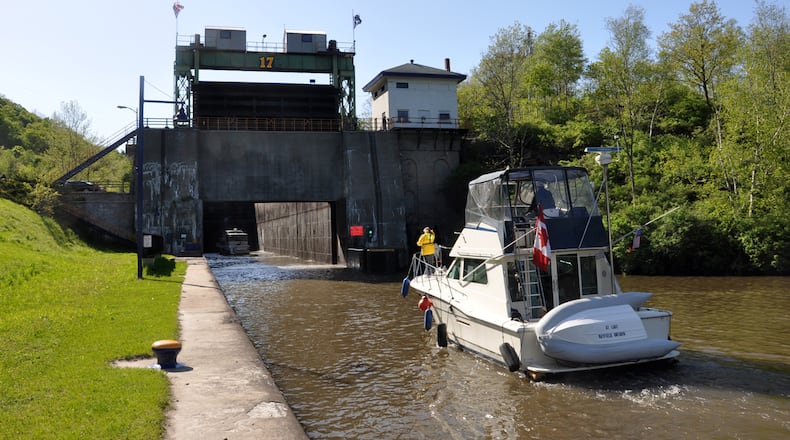The Donnellys, like many people these days, are using the Erie Canal for pleasure, not business — a sea change from the original intent of this historic waterway that altered the face of commerce across New York and the Midwest by linking the Hudson River to the Great Lakes. Construction on this engineering feat began 200 years ago this month.
Although superseded by the railroads and New York State Thruway, both of which mirror the canal’s route up the Mohawk River valley and west to Buffalo, N.Y., it still carries barges hauling freight too large to ship by land or air. But the canal is primarily for pleasure craft that glide through stunning countryside. The recreational boats are lifted or lowered through 35 elevation locks, docking at towns built along the celebrated thoroughfare of water.
When the labor-intensive construction finished in 1825, the canal enabled settlers to sail west, while grain moved east on slender, shallow-draft wooden vessels. It transformed New York City into America’s largest port and turned outposts like Cleveland and Chicago into mercantile hubs. The Erie’s learn-as-you-go engineering created technological advances that made later canals at Suez and Panama possible.
Credit: Erie Canalway National Heritage
Credit: Erie Canalway National Heritage
You can drive alongside much of the 338-mile canal and see how the past and present collide. The state of New York has issued shoals of driving and bicycling maps and brochures for the bicentennial. Instead of the 41/2-hour Interstate-90 toll-road zip from Albany to Buffalo, you can connect the canal-port dots on smaller highways.
Some parts of the original 40-foot-wide ditch, which was deepened and widened before the Civil War and expanded again a century ago, are still in use; others are ever-narrowing weed troughs. Many towns that depended on canal shipping now tout canal tourism, with inns and eateries catering to recreational boaters and other visitors who hike and bike along paved trails running along the canal corridor.
Got a kayak or canoe? Bring it. And you don’t have to travel as leisurely as the Donnellys, whose blog (serenitysstory.blog) says they’re moving at 41/2 mph — just a tad faster than back in the day when mules on towpaths pulled boats of people and produce in the 1830s.
If you’re traveling along the canal, here are some cool places to see:
—Historic downtown Waterford, which plays up its status as the eastern end of the original canal, is a charmer. (The canal’s eastern terminus is now less than half a mile south, in a deeper Mohawk River channel.) Pleasure craft dock at Waterford’s landing, and the city is dotted with painted, life-size Fiberglas mules. There are hiking trails, exhibits and scenic overlooks at nearby Peebles Island State Park. Learn about the canal’s story at the Waterford Historical Museum.
—At Fort Hunter, west of Schenectady, quiet Schoharie Crossing State Historic Site is where you can see the rare remains of an aqueduct created for the early 1800s canal. The picturesque Dutch-founded town of Amsterdam is nearby on the Mohawk River.
—The city of Little Falls had the foresight to keep its old canal warehouses intact. Today, they house boutiques in what’s called Canal Place.
—At tiny Chittenango, once a hub of canal-boat building and repair, the Chittenango Landing Canal Boat Museum features a replica canal boat and other nifty touches. “The Wonderful Wizard of Oz” author L. Frank Baum was born in Chittenango in 1856, and the village has various Oz-inspired touches, including the Yellow Brick Road Casino.
—In downtown Syracuse where the original canal flowed, you can see dozens of artifacts and poke around a canal boat replica at the Erie Canal Museum, in the old Weighlock Building, where tolls were assessed by poundage.
—The kid-friendly Rochester Museum & Science Center has a slick, hands-on model of a lock, while the town of Lockport is where locks — seven initially, two today — raise and lower watercraft 167 feet, the same distance as the natural plunge at nearby Niagara Falls. Take a narrated boat trip with Lockport Locks & Erie Canal Cruises.
—North Tonawanda, the canal’s western end since the 1917-1918 enlargement of the waterway, is where the canal feeds into the Niagara River. A beautifully developed canalside docking area awaits in the spruced-up, early-1900s downtown once home to factories for Wurlitzer organs and Herschell carousels.
—As the canal’s original Lake Erie terminus, Buffalo became America’s eighth-largest city. To emphasize that heyday heritage, Buffalo has excavated and revived its largely abandoned canal bed as Canalside, an inviting urban park and recreational development where you can catch a concert and rent kayaks in warm weather or ice bikes in winter.
In Victorian times, Canalside was where crews of eastbound Midwest grain freighters were paid — and where wages were squandered on booze and floozies.
Larry Mruk, who leads compelling walking tours for Explore Buffalo, said this is the spot that inspired the folk song “Buffalo Gals,” those painted ladies who’d come out at night and dance by the light of the moon.
———
(John Bordsen is a freelance writer.)
About the Author


